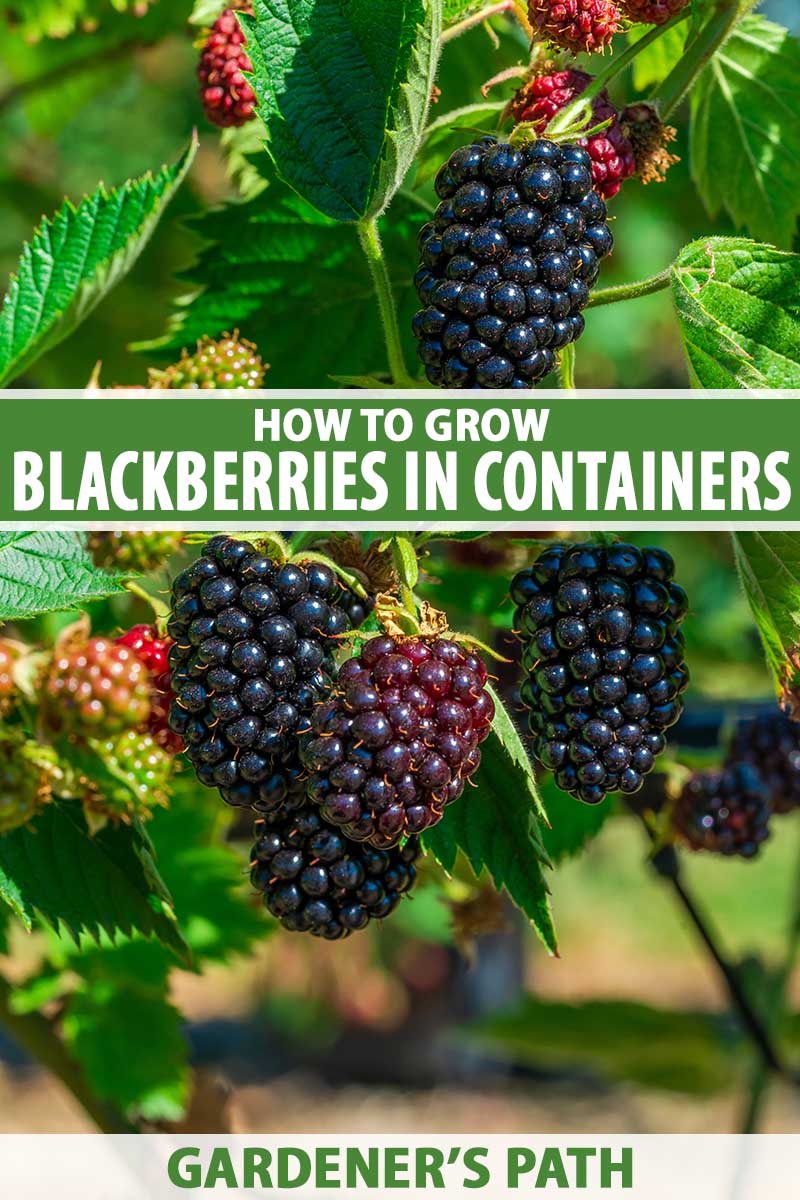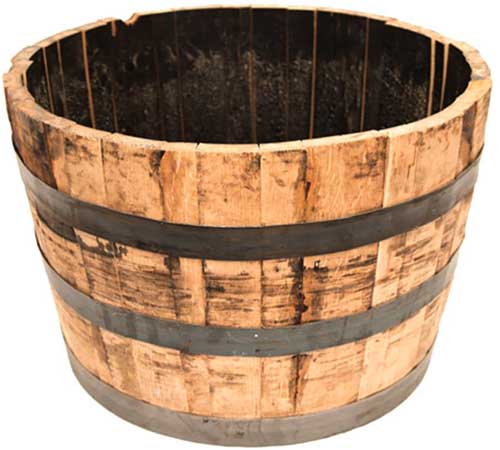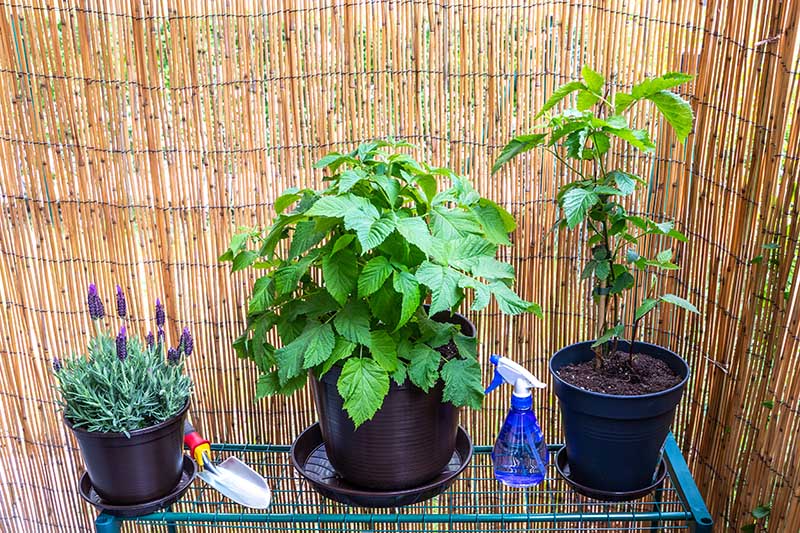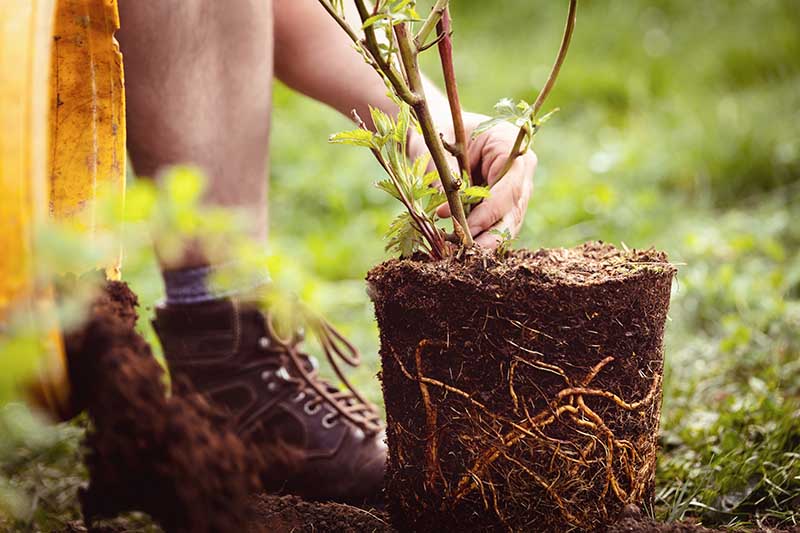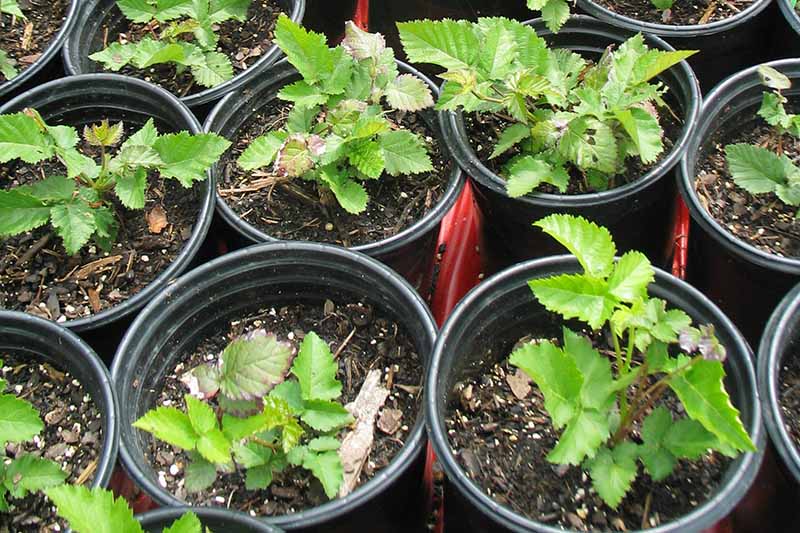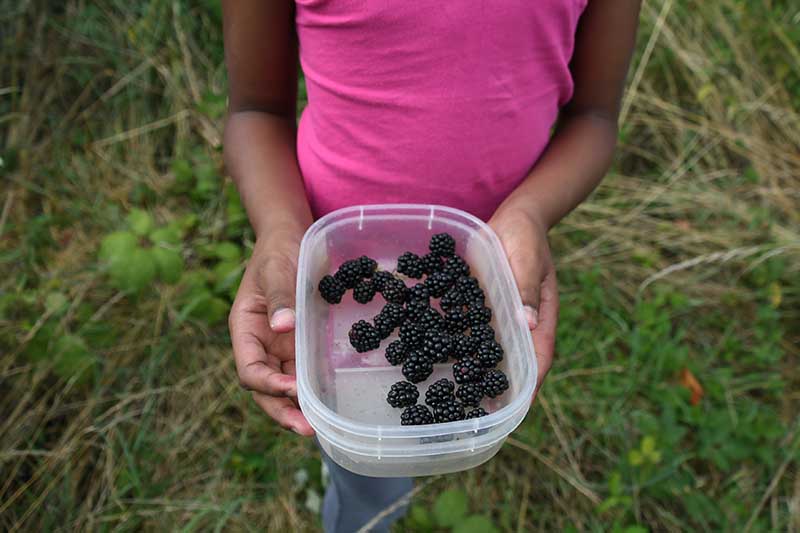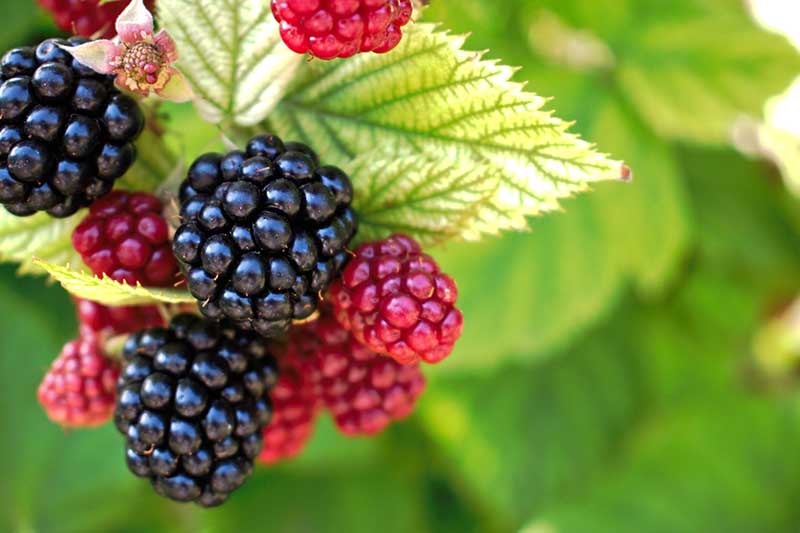How wonderful it would be, I thought, if I had a whole thicket of blackberries to wander through and pick from at leisure? Well, that never happened, but I won’t forget the time we bought a blackberry for my mom for Mother’s Day and put it in a container to grow. It may not have been a whole patch, but it was special nonetheless. We link to vendors to help you find relevant products. If you buy from one of our links, we may earn a commission. Here’s what I’ll cover:
A Bit About Blackberries
Blackberries are brambles, or cane berries, that belong to the Rosaceae family. They bear fruit on biennial stems, which are known as canes – hence the moniker “cane berry,” which also applies to closely related raspberries, along with blackberry and raspberry hybrids and cultivars like marionberries, boysenberries, olallieberries, and loganberries. In the first year, a blackberry plant will put out green, tender primocanes, which grow leaves but not flowers or fruits in most cases. After a year of growth and dormancy, the former primocanes become woody, and are then called floricanes. These bear flowers and fruit on lateral stems. Plants can be classified as erect, semi-erect, or trailing. A number of Rubus species are considered to be types of blackberries; R. allegheniensis, R. argutus, R. armeniacus, R. laciniatus, R. ulmifolius, and R. ursinus are six of the most notable. But dozens of cultivars exist today, and they’ve been bred so extensively that it’s hard to pinpoint which wild species contributed to their creation in many cases. Nevertheless, we are grateful to breeders for cultivating blackberry bushes to have few or no thorns, or to grow just three to four feet tall, or even to bear fruit on primocanes. Regardless of the cultivar, the fruits are typically around an inch in length – sometimes larger and sometimes smaller – and are both sweet and tart, sometimes more of one than the other, depending on the cultivar. The berries are antioxidant-rich and contain high levels of vitamins C, E, and K, manganese, and calcium. They’re also high in fiber: a one-cup serving contains eight grams! Blackberries prefer loamy, well-draining soil with a pH between 5.5 and 7.5. They are hardy in Zones 4 through 9. They tend to grow anywhere from three to 10 feet tall with a similar spread, which might have you asking why in the world you’d want to grow them in containers. We’re glad you asked.
Why Grow in a Container?
You know how we mentioned that these plants have an impressive sprawl? If you crave blackberries but don’t want an enormous thicket of them, planting them in containers is a good way to keep the canes in check. For starters, they won’t be able to reproduce easily via underground rhizomes. They’ll only go as far as the container allows, which means they can’t overtake your yard or garden. This is especially true of erect or semi-erect cultivars. Trailing plants are really only ideal for container growing if you plan to train them on a trellis. And you’ll have to watch out for stray canes that come into contact with the ground outside of the container, because they’ll put down roots. If, on the other hand, you live in an apartment, a home with a small yard, or a rental where the landlord doesn’t want you to plant anything directly into the ground, you can simply grow your crop in a container. Plus, there are several compact varieties that you can grow in containers without worrying too much about running out of room. With regular pruning, you can keep your little berry thicket small and fruitful for years.
Choosing the Right Container
Whatever container you choose, make sure it’s at least 24 inches in diameter and 12 inches deep. This will give your plant ample space to stretch and grow. Whiskey Barrel Planter A whiskey barrel planter that is at least 24 inches in diameter, like this one that’s available from the Home Depot, is a perfect choice. Plus, by planting it in a large container to start with, you won’t have to worry about transplanting it into something bigger just a few years later. If you must, you can get away with putting your plant in an even smaller container – around 12 to 15 inches wide and at least six inches deep. But you’ll need to plan to transplant it into a larger container once it begins showing signs of being rootbound: yellow, wilting leaves; an increase in pest and disease issues due to stress; or a consistently small yield of fruit. Since blackberries can get top-heavy during fruiting season, it’s wise to invest in a container made of wood, stone, or heavy plastic to prevent it from toppling over. Whichever pot you choose, make sure it has drainage holes or cracks to prevent the soil becoming oversaturated.
Preparing Your Pot
The easiest way to get started with your container-grown blackberries is to purchase a bare root or live plant from a nursery. Bare roots are best planted in the springtime, whereas live plants can go in the pot any time in the spring or summer. Blackberries need full sun in order to thrive, so find a spot on your deck or balcony, or in your garden, that receives at least six to eight hours of sunlight every day. If you’ve purchased a bare root, place it in a bucket of room-temperature water to soak for up to two hours before planting. If you choose this option, you’ll also want to mix in a 10-10-10 NPK fertilizer according to package instructions. I use Nature’s Care potting mix from Miracle-Gro, available from the Home Depot, because it feeds any plant for up to two months – and for blackberries, that’s all you need in the first year. Miracle-Gro Nature’s Care Potting Mix Alternatively, you can fill your container with a mixture of one-third topsoil, one-third perlite or vermiculite for drainage, and one-third well-rotted manure or compost. I do not recommend that you use soil from your garden in your pot as this can introduce unwanted pests or diseases. Whatever you do, don’t add soil that’s previously been used to grow any type of cane berries, roses, or any members of the Rosaceae family, as this increases the likelihood of the soil hosting diseases or pests that can damage your blackberry plants. Once your container is full, create a hole with the depth and width of the bare root or root ball of the live plant you’re transplanting. Carefully place the plant inside the hole and backfill the hole with soil. Water slowly, until water drains out the bottom of the container.
How to Grow
It’s important to keep the soil moist, especially when your plant is working on establishing its root system in the new container. Since container soil dries out faster than the dirt in an in-ground garden, it’s wise to check it each day with your finger. If it feels dry an inch down, it’s time to water the plant again. Adding a two-inch layer of mulch can help to lock moisture in, which is especially important in hot, dry climates. I love using bark mulch, but any mulch will do. Every spring, just as new growth is beginning to appear, fertilize your plant with a 10-10-10 NPK fertilizer according to package instructions. Or, add several handfuls of compost or well-rotted manure. Read our guide to fertilizing blackberries for a full laydown. I like to add several scoops of fresh potting mix to my containers in the spring, too, to freshen up the pot and get it ready for a new growing season. Early spring is also a good time to prune the plant back to three feet in height, and snip the lateral branches back to about 12 inches in length. The blackberries will need another pruning in the fall. Cut all the spent floricanes off the plant and trim the central canes down to three feet again. Laterals should be trimmed back to 12 to 15 inches. Primocane-fruiting blackberries are even easier to care for, since there’s no need for a spring pruning. All you need to do is cut the spent floricanes back to the ground every fall after the plant enters dormancy, and leave the primocanes alone. The following year, you’ll get fruit on last year’s primocanes again – now called floricanes – in the summer, and on the newly grown primocanes in the fall. Throughout the growing season, remove any broken, dead, or diseased canes. If you live in Zones 7 and above, a fresh two-inch layer of mulch put in place before winter hits should keep your plant happy during dormancy by protecting the roots from cold temperatures. But gardeners in Zones 4 through 6 need to give theirs a bit more protection. After the fall or winter’s first hard frost, enlist some help to move your container into a sheltered space like a garage or a shed.
Growing Tips
Check soil moisture daily; if it’s dry one inch down, water the plant.Fertilize every spring with 10-10-10 NPK fertilizer.Prune in the spring and again in the fall.Mulch to help retain moisture and to protect against winter cold.
Cultivars to Select
Fifty years ago, you would’ve had a lot of trouble growing blackberries in containers. Imagine trying to fit a sprawling, wild blackberry that grows up to 10 feet tall in a 24-inch pot! Or, you can leave it where it is, mulch with at least six to eight inches of straw, and place a breathable plant insulation bag over the canes, like this one from the Home Depot. Drawstring Frost Plant Cover Regardless of which method you used to overwinter your plants, you’ll need to keep tabs on the soil moisture each week during the winter. If it’s frozen, don’t water it. If it is not frozen, water it a few times a month, just barely enough to keep the soil from drying out. Thanks to extensive breeding, there now exist two cultivars that shine as container-grown plants.
Managing Pests and Disease
The best cultivars to grow in containers are also bred to be the most disease resistant, so container grown blackberries have a leg up when it comes to fighting off unwanted plagues. Thornless and erect, ‘Baby Cakes’ bears fruit on primocanes and floricanes, so you’ll get a crop from the first year of planting. ‘Baby Cakes’ is hardy in Zones 4 through 8, blooms with white flowers in the spring, and bears juicy fruits on floricanes in midsummer and then again on primocanes in the fall. ‘Baby Cakes’ Developed by breeders at the University of Arkansas, and also known as ‘APF-236T,’ ‘Baby Cakes’ is part of the Bushel and Berry® Collection, distributed by Star® Roses and Plants. This dreamy cultivar won the Best in Show award at the Farwest Show in Portland, Oregon in 2016 and became available to the public in 2017, so it’s a relatively new treat. The berries are large, juicy, and sweet. You can find live plants in two-gallon containers from Nature Hills Nursery.
Natchez
Do you long for a cultivar that’s prized for its extra-sweet flavor but also fits in a container? Then ‘Natchez’ is your berry. Hardy in Zones 5 through 9, the thornless, semi-erect ‘Natchez’ grows to between four and five feet tall, and spreads three to four feet. Since it’s semi-erect, you may need to use a tomato cage or a similar support with your container-grown plant. But you won’t need to trellis it – unless you want to. ‘Natchez’ A disease-resistant, floricane-fruiting cultivar, ‘Natchez’ blooms with pretty pinkish-white flowers in the early spring. In June, the pollinated blooms ripen into large, super-sweet berries. Like other outstanding blackberry cultivars, ‘Natchez’ was bred by horticulturists at the University of Arkansas. You can find live plants available from Burpee. Another bonus of growing these brambles in containers is that they’re more self-contained and aren’t prone to spreading and tangling with other plants, thus increasing the chance for pest infestations. Blackberries aren’t highly susceptible to pests or disease. But keep an eye out for anthracnose, blackberry rosette, and cane rust, and closely inspect your plant every few days to stay ahead of any aphid or Japanese beetle infestations. Avoid overhead watering to help keep fungal infections away, and if you do see any signs of fungal infection, such as gray lesions or spots on the leaves, spray the plant with copper fungicide. For pests – especially aphids – a neem oil-based spray works wonders.
Harvesting and Preserving
Once the berries turn from bright red to dark purple or black, they’re ready to harvest. Go out to your container garden in the morning, when the berries are freshest for picking. If you’ve chosen to grow a prickly variety, wear a long-sleeved shirt and a pair of gloves to ward off injuries. To harvest, gently tug on each berry to remove it. The fruit should come off easily, core intact. Keep in mind that the berries in a single cluster won’t all ripen at once, so check your garden regularly. Eat them or bake them into a pie or tart right away. This might not be possible if you only grow one plant, but if you have two or more plants ripening at once, you should have enough for a dreamy, homegrown pie. To freeze your harvest for later, wash the berries and allow them to dry before spreading on a baking sheet in a single layer. Let them freeze for several hours, and then transfer to a freezer-safe bag or container for storage. If you have extra freezer safe canning jars and lids lying around, these make fantastic containers for hand-picked berries. I always have a jar or two full of berries in my freezer. And of course, if you’re one of those wise people who knows how to make jam, have at it and send me a jar when you’re done! (I can dream, right?)
Recipes and Cooking Ideas
On a hot summer day, I adore refreshing my tastebuds with this blueberry pomegranate chia fresca from our sister site, Foodal, except I use blackberries instead of blueberries to make it. Or, you can combine the two for a blackberry-blueberry pomegranate chia fresca. Yum! Another favorite of mine is this recipe for berry peach crisp, also from Foodal, made with blackberries instead of blueberries. Served warm with ice cream on the side, of course. And you can always toss the berries into scones, muffins, smoothies, and more! Have you ever grown cane berries in a container? We’d love to hear your stories and questions in the comments below! And for more information on growing berries in your garden, check out these guides next:
Sweet and Juicy Tips for Starting Your Own Berry PatchHow to Grow BlueberriesThe Benefits of Boysenberry: Why You Need This Brambly Hybrid in Your Life
